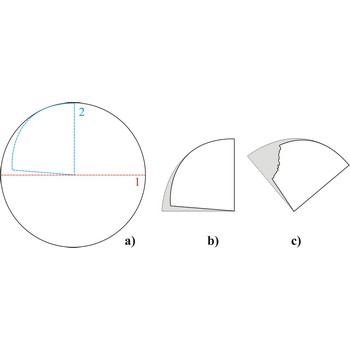filter paper → filtar papir
Filter paper is a quantitative paper used for filtering and made of pure cellulose treated with hydrochloric and hydrofluoric acid. This kind of paper burns out practically without any remains (less than 0.0001 g ashes). Different types of paper are marked with numbers; qualitative bears marking 595 or 597 and quantitative 589 or 590. Dependable upon precipitate character, different types of filter paper are used:
- black band (5891) - 100 mL of fluid flows through it in 20 s to 30 s. It is used for filtering of gelatinous precipitates.
- white band (5892) - 100 mL of fluid flows through it in 40 s to 60 s. It is used for coarse crystalline precipitates filtration.
- blue band (5893) - 100 mL of fluid flows through it in 200 s to 400 s. It is used for fine crystalline precipitates.
polariser → polarizator
Polariser is frequently a specially made prism from crystal of Iceland Spar (form of calcium carbonate), also known as Nicol’s prism. It can also be a small plate of tourmaline.
flammable limit → granica zapaljivosti
Flammable limits refer to the conditions under which a mixture of a flammable material and air may catch fire or explode. When vapour s of a flammable or combustible liquid are mixed with air in the proper proportions in the presence of a source of ignition, rapid combustion or an explosion can occur. The proper proportion is called the flammable range and is also often referred to as the explosive range. The flammable range includes all concentrations of flammable vapour or gas in air, in which a flash will occur or a flame will travel if the mixture is ignited.
The lower flammable limit (LEL) or the lower explosive limit is the lowest concentration of a flammable vapour or gas in air that will propagate a flame from an ignition source. The upper flammable limit (UEL) or the upper explosive limit is the highest concentration of a flammable vapour or gas in air that will propagate a flame from an ignition source. Any concentration between these limits can ignite or explode.
fluorine → fluor
Fluorine was discovered by Henri Moissan (France) in 1886. The origin of the name comes from the Latin word fluere meaning to flow. It is pale yellow to greenish gas, with an irritating pungent odour. Extremely reactive, flammable gas. Reacts violently with many materials. Toxic by inhalation or ingestion. Does not occur uncombined in nature. Fluorine is found in the minerals fluorite (CaF2) and cryolite (Na3AlF6). Electrolysis of hydrofluoric acid (HF) or potassium acid fluoride (KHF2) is the only practical method of commercial production. Used in refrigerants and other fluorocarbons. Also in toothpaste as sodium fluoride (NaF).
polyvalent element → polivalentni elementi
Polyvalent element is a molecule which having more than one valence, for example oxygen is a divalent in H2O, nitrogen is a trivalent in NH3, carbon is a tetravalent in methane (CH4).
potassium glass → kalijevo staklo
Potassium glass is a type of glass produced from potassium silicates and calcium with potassium carbonate. It dissolves harder than regular glass and it is used in production of chemical vessels.
protelysis → proteoliza
Proteolysis is hydrolytic decomposition of proteins with enzymes, for example trypsin.
qualitative properties → kvalitativna svojstva
Qualitative properties are descriptional properties that cannot be defined by precise mathematical values, e.g. scent, taste and colour.
Citing this page:
Generalic, Eni. "Ledište." Croatian-English Chemistry Dictionary & Glossary. 29 June 2022. KTF-Split. {Date of access}. <https://glossary.periodni.com>.
Glossary
Periodic Table

